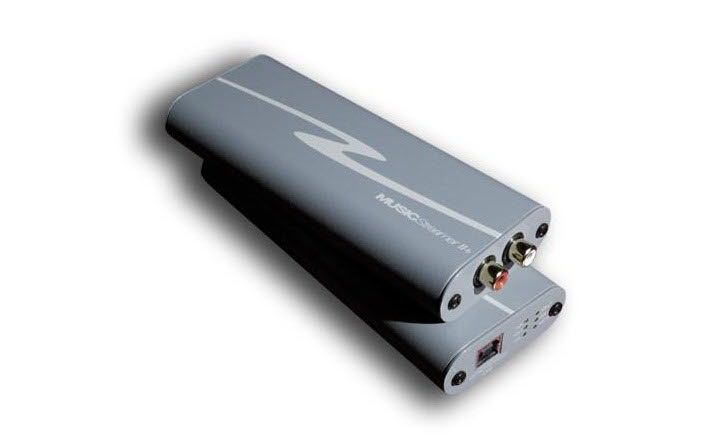
If you are just getting into computer audio, the first question to address is how to get the digital audio files off your computer and into you stereo system. The simplest, but likely the least attractive, choice is to use the line output of your soundcard or your headphone jack into your preamplifier, integrated amplifier or active speakers. A better choice is to use the digital output, either Toslink or coaxial S/PDIF, into a DAC. That is fine for a desktop, but is not available on any Windows laptop I am aware of. If you have a MacBook, you can use the mini Toslink output which is integrated with the headphone jack. Firewire output is a possibility if you have one, and are willing to limit yourself to a semi-professional or professional interface, or the superb Weiss INT202 Firewire to S/PDIF converter ($1885) or Weiss DAC202 Firewire DAC ($6670). Increasing though, a USB to S/PDIF converter like the Halide Design Bridge (which I reviewed here) or the Audiophilleo2 (which I reviewed here), or a USB DAC like the High Resolution Technologies (HRT) MusicStreamer II+, which is the subject of this review, is the way to go.
The MusicStreamer II+ ($349) is one step up from HRT”S entry-level MusicStreamer II model ($149), and has a lower noise floor, a better signal-to-noise ratio, and less total harmonic distortion to show for its higher price. It is a small, powder-coated steel unit measuring 5.6″ long by 2.3″ wide by .875″ high. I am not sure of its weight, but I can tell you it is solidly built. At one end is a Type B USB jack and a series of green LEDs indicating the incoming sample rate from 32kHz to 96kHz, and at the other end are the left and right analog line output RCA jacks. It requires no external power supply, deriving the 400mv DC power it needs directly from the USB bus. You can also use the USB jack to update the firmware in the MusicStreamer II+ should it ever be required.
I used the MusicStreamer II+ with the USB output of my custom music server as well as my IBM ThinkPad X61 laptop, both of which are running Windows 7 and iTunes version 10.5.3. In both cases, once plugged in, the computer does its usual dance, automatically installing drivers for a USB audio device, a USB human interface device and an HID-compliant device. It sounds more involved than it is; it only takes a few seconds, and the MusicStreamer II+ then pops up in the Control Panel sound applet. I assume the process is even more seamless on a Mac. A quick check confirmed it worked with 44.1/16, 48/24, 88.2/24 and 96/24 files. Thankfully, I don’t have any files sampled at 32kHz at any bit depth, and I hope you don’t either, but if you do, I assume it would work with them as well.
The two USB DACs I had on hand to compare the HRT MusicStreamer II+ with were the Furutech ADL GT40 ($525), which I reviewed here, and the Benchmark DAC1 HDR ($1895), which will be the subject of an upcoming review. Both are multi-function devices. In addition to being a USB DAC, the ADL GT40 also offers a MC/MM phono preamplifier, an analog line input, and a headphone amplifier. Similarly, in addition to being a USB DAC, the Benchmark HDR offers an analog input, one Toslink and three coaxial S/PDIF inputs, and a headphone amplifier. In addition, it has both balanced and unbalanced outputs and a remote control. The feature sets of the ADL GT40 and the Benchmark HDR clearly account for their greater cost. I only compared the USB DAC stages of the respective devices
Conclusion
I listened to a wide variety of music – opera, classical, jazz, rock and bluegrass - and found little, if any, difference in the performance between the MusicStreamer II+ and the ADL GT40. Unless you need the additional features of the ADL GT40, save a couple of hundred dollars and go with the MusicStreamer II+. Consider its smaller size and lack of external power supply a bonus. I did find the Benchmark DAC to be superior by a small margin. Its presentation was somewhat smoother with better low frequency extension and a warmer midrange. This was especially evident on solo piano music, where left hand chords tended to resonate more fully when sustained, though it also manifested itself on female vocals.
To what do I attributed this? I am not altogether certain. The MusicStreamer II+ has an asynchronous USB interface, which, generally speaking, results in lower jitter than the adaptive interface employed by the Benchmark HDR. Then again, the performance differential is affected not only by choice of interface, but by its implementation. Ultimately, I think the difference can be attributed to the analog stage in the Benchmark HDR. At five times the cost, one would expect the Benchmark to have the edge. Nevertheless, unless you pitted the two head to head in a careful audition, I doubt you would notice the differences, making the Music Streamer II+ not only a bargain, but an easy recommendation, especially if all you need is a USB DAC.
- Frank Berryman
Contact Information
High Resolution Technologies
Los Angeles, California
(323) 967-7447
http://www.highresolutiontechnologies.com
Associated Equipment
Analog Source: VPI Scout; Dynavector 20X2 Special; Musical Surroundings Phonomena II
Digital Source: Windows 7 music server with ESI Juli@ soundcard; Halide Design USB to S/PDIF Bridge; Furutech ADL GT40
Preamplifier: Meridian G68ADV; Benchmark DAC1 HDR
Power Amplifier: Meridian 557
Loudspeakers: Meridian DSP5500; Dali IKON 6 MK2
Headphones: Etymotic ER-4S

